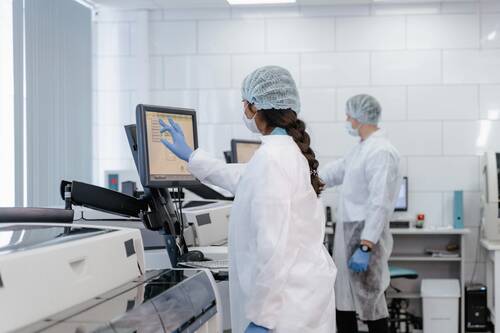
12 Sep A Quick Guide to Downstream Bioprocessing in Biotechnology
Downstream bioprocessing plays a crucial role in biotechnology, transforming raw biological materials into valuable products. It encompasses a series of steps that isolate, purify, and concentrate biosynthetic substances after their initial production. Downstream processing aims to refine and prepare biopharmaceuticals and other biotechnology products for safe, effective use.
This critical phase of manufacturing involves various techniques such as filtration, chromatography, and centrifugation. Each step in the downstream process is carefully designed to remove impurities, concentrate the desired product, and ensure its stability. The efficiency of these operations directly impacts the quality and cost-effectiveness of the final biotechnology product.
Advances in downstream bioprocessing have significantly improved the production of pharmaceuticals, enzymes, and other biological compounds. As the biotechnology industry continues to evolve, optimizing downstream processes remains a key focus for enhancing overall bioprocess efficiency and product yield. This guide will explore the essential components of downstream bioprocessing and their importance in modern biotechnology applications.
Core Components of Downstream Bioprocessing
Downstream bioprocessing involves several key stages to isolate and purify biopharmaceutical products.
These components work together to transform raw cell culture into high-quality, purified biologics.
Cell Culture and Harvesting
Cell culture serves as the foundation of biopharmaceutical production. Cells are grown in controlled bioreactors to produce the desired proteins or molecules. Once the culture reaches optimal yield, harvesting begins.
Centrifugation is often used to separate cells from the liquid medium. This process concentrates the cells and removes large debris. Filtration techniques, such as depth filtration or tangential flow filtration, further clarify the harvested material.
The harvesting step is critical for maximizing product yield while minimizing impurities. Careful optimization of harvest conditions can significantly impact downstream purification efficiency.
Initial Recovery and Separation
After harvesting, the next phase focuses on isolating the target molecule from cellular components and culture medium. This stage typically employs a combination of techniques.
Precipitation methods can selectively separate proteins based on their solubility. Adjusting pH, salt concentration, or temperature can trigger precipitation of target molecules or contaminants.
Extraction processes may be used for products expressed inside cells. Cell lysis techniques release intracellular contents, followed by centrifugation or filtration to remove cell debris.
Membrane-based separations, like ultrafiltration, concentrate the product and perform initial purification. These methods can efficiently handle large volumes and remove small molecule impurities.
Purification Strategies
The final purification stage aims to achieve high product purity through selective separation techniques. Chromatography plays a central role in this process.
Affinity chromatography utilizes specific interactions between the target molecule and ligands immobilized on a solid support. This method offers high selectivity for many biologics.
Ion exchange chromatography separates molecules based on charge differences. It’s effective for removing process-related impurities and adjusting product formulation.
Size exclusion chromatography can provide final polishing, separating molecules based on size. It’s useful for removing aggregates and achieving desired product specifications.
Optimization of purification steps is crucial for maximizing yield and purity. Factors like buffer composition, flow rates, and column selection significantly impact performance.
Optimization and Scaling of Bioprocessing
Downstream bioprocessing optimization and scale-up are crucial for efficient and cost-effective production of biomolecules. Key strategies focus on enhancing purification techniques, improving process efficiency, and addressing challenges in large-scale manufacturing.
Process Optimization Techniques
Optimization of downstream bioprocessing aims to maximize product yield and purity while minimizing costs. Chromatography techniques, such as protein A affinity chromatography, play a vital role in purifying biomolecules. Advanced automation systems enable precise control of process parameters, enhancing reproducibility and efficiency.
Novel purification methods, including membrane-based separations and continuous processing, offer faster and more cost-effective alternatives to traditional batch operations. These techniques can significantly reduce processing times and increase overall productivity.
Process analytical technologies (PAT) provide real-time monitoring and control of critical quality attributes, allowing for rapid adjustments and improved product consistency.
Scale-Up Considerations in Bioprocessing
Scaling up bioprocessing operations from laboratory to commercial production presents unique challenges. Engineers must carefully consider equipment design, process parameters, and material properties to maintain product quality and yield at larger scales.
Key factors in successful scale-up include:
- Maintaining consistent hydrodynamics and mass transfer
- Ensuring uniform temperature and pH control
- Optimizing buffer volumes and filtration capacities
- Implementing robust cleaning and sanitization procedures
Pilot-scale studies play a crucial role in identifying potential issues and optimizing process conditions before full-scale implementation. This approach helps mitigate risks associated with scale-up and ensures smooth technology transfer to manufacturing facilities.
Challenges and Opportunities in Bioprocessing
The biopharmaceutical industry faces ongoing challenges in downstream processing, including high costs and complexity of purification steps. However, these challenges also present opportunities for innovation and improvement.
Emerging technologies, such as single-use systems and continuous bioprocessing, offer potential solutions to reduce costs and increase flexibility in manufacturing. These approaches can lead to smaller facility footprints and faster product changeovers.
Leaders in the space, like LifeSynth Solutions (see website here – https://www.lifesynthsolutions.com/), use these types of technology to streamline their processes and increase customer success.
Advances in protein engineering and host cell line development are enabling the production of easier-to-purify biomolecules, simplifying downstream processing requirements. This trend towards “designed” molecules can significantly impact purification strategies and overall process efficiency.
Integration of artificial intelligence and machine learning algorithms in process development and optimization holds promise for faster, more robust bioprocessing operations.
————————
The information on MedicalResearch.com is provided for educational purposes only, and is in no way intended to diagnose, cure, or treat any medical or other condition.
Some links may be sponsored. Products, included compounded prescriptions above are not warranted or endorsed.
Always seek the advice of your physician or other qualified health and ask your doctor any questions you may have regarding a medical condition. In addition to all other limitations and disclaimers in this agreement, service provider and its third party providers disclaim any liability or loss in connection with the content provided on this website.
Last Updated on September 17, 2024 by Marie Benz MD FAAD
